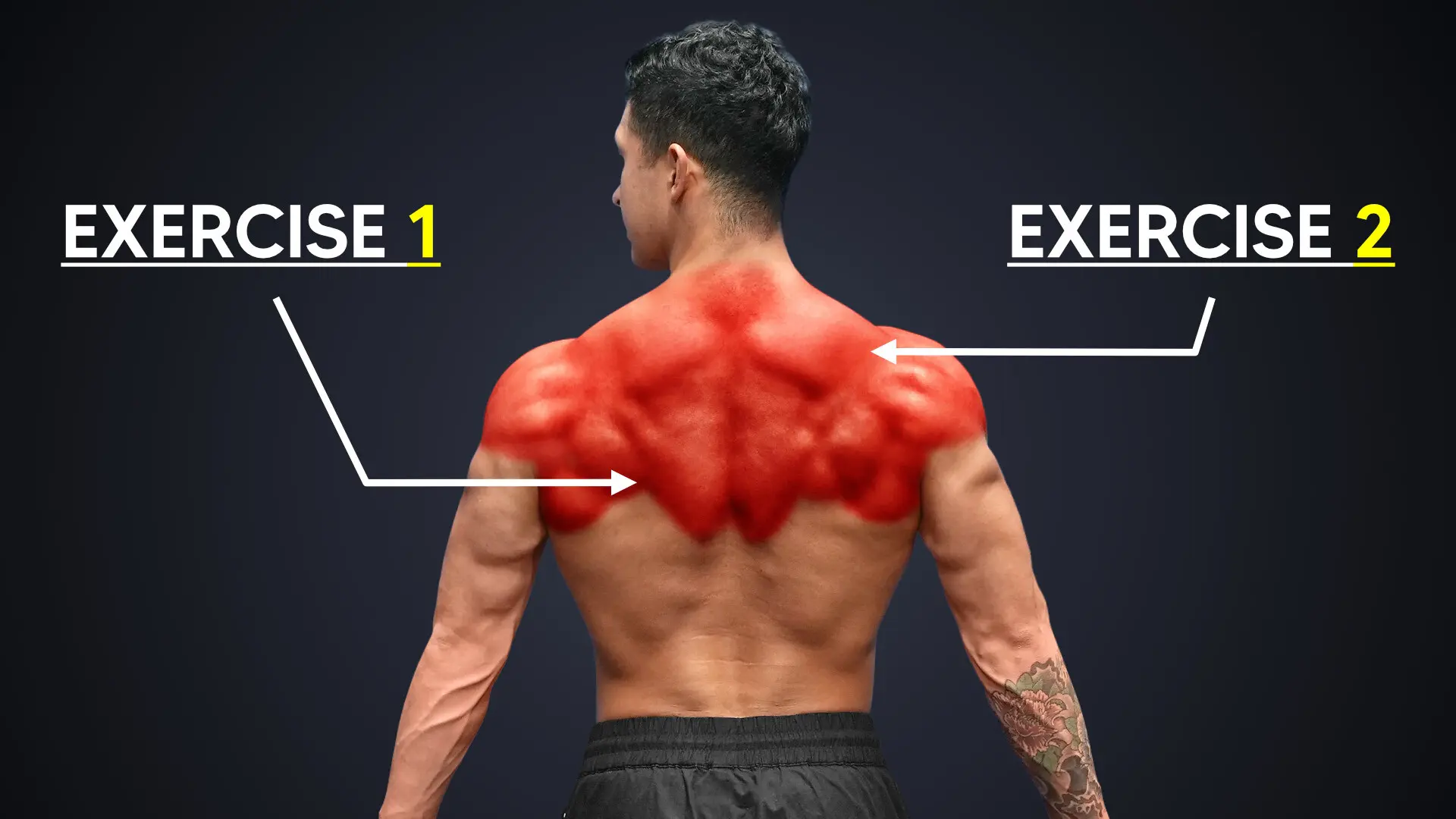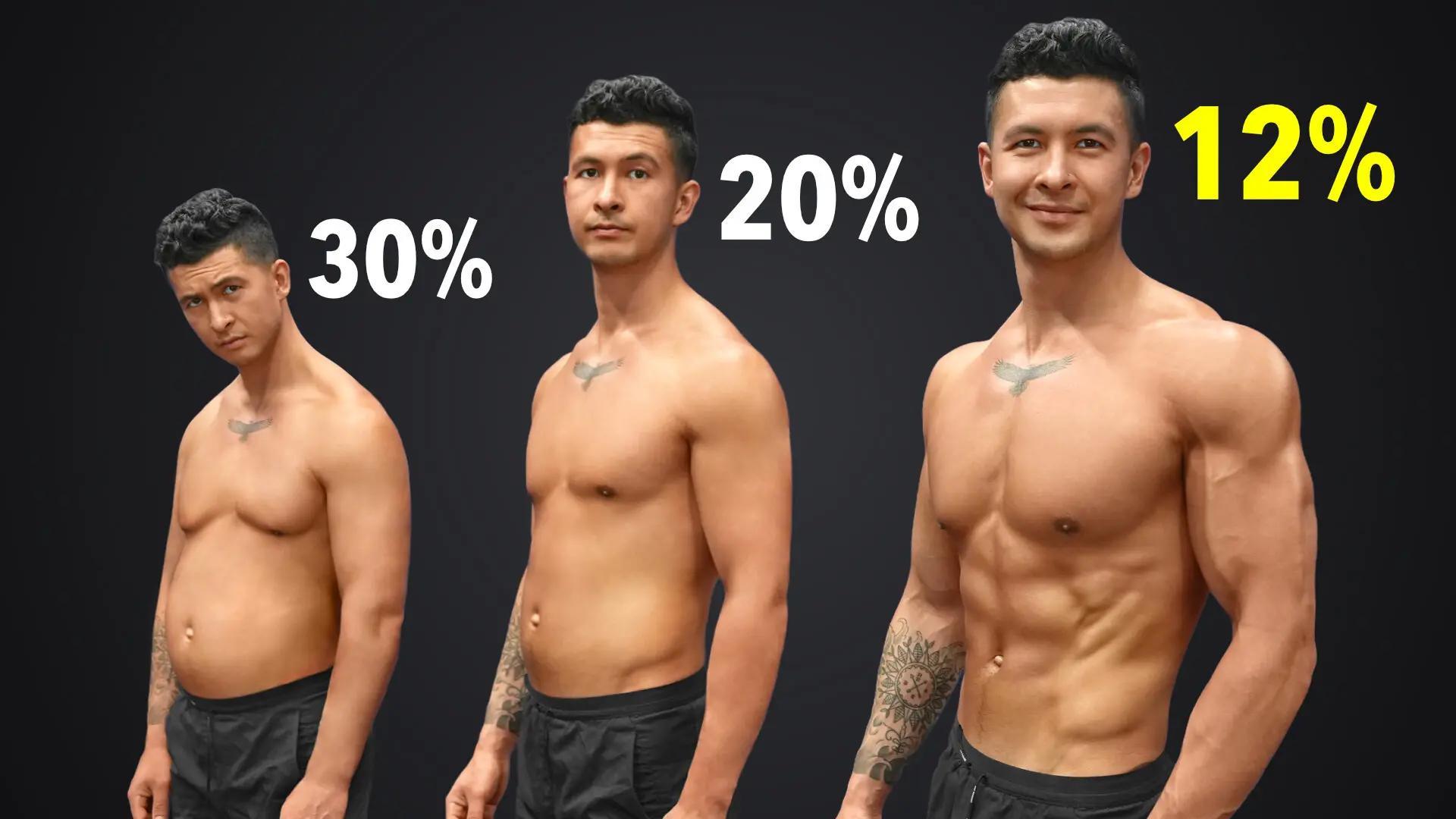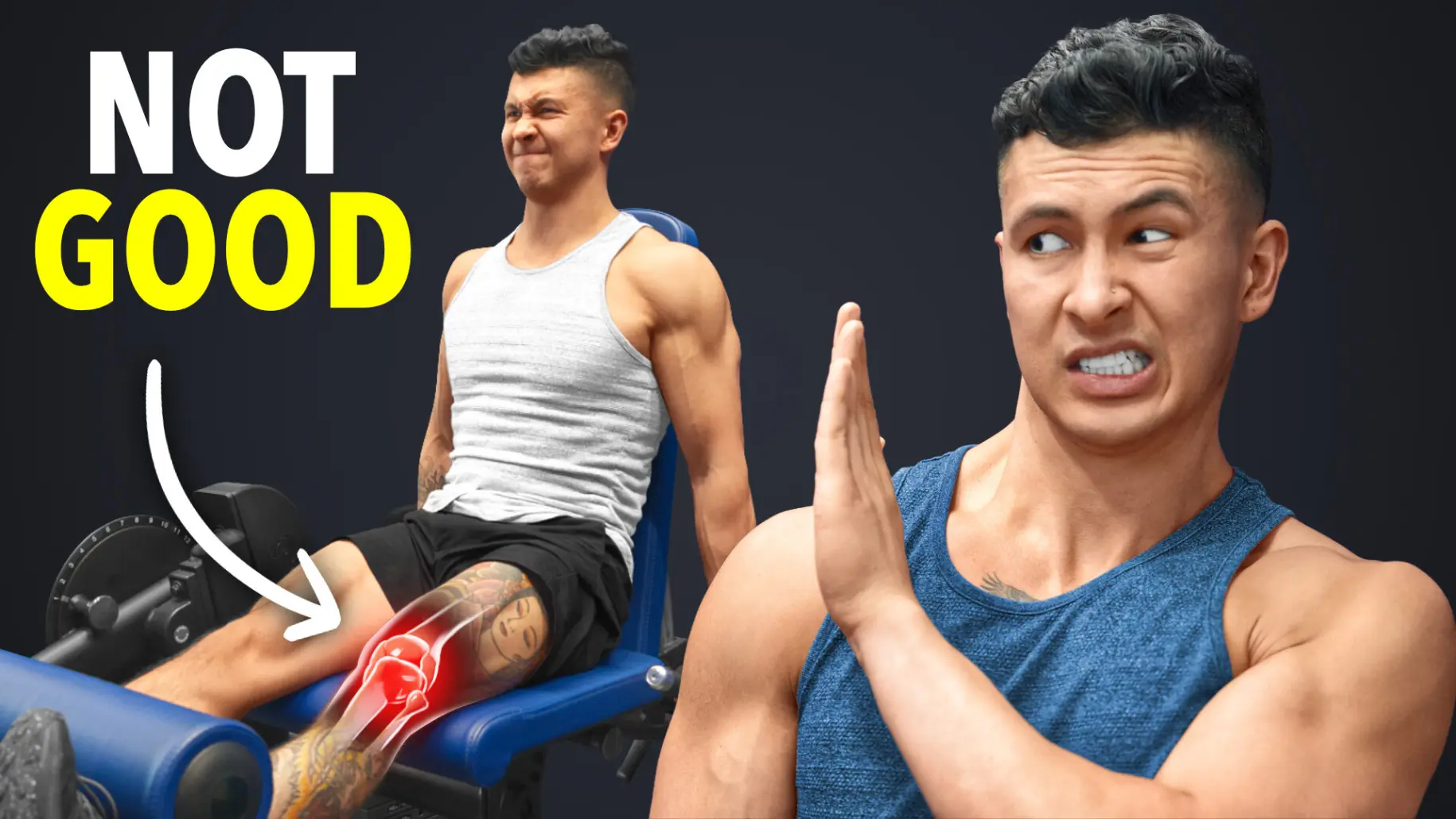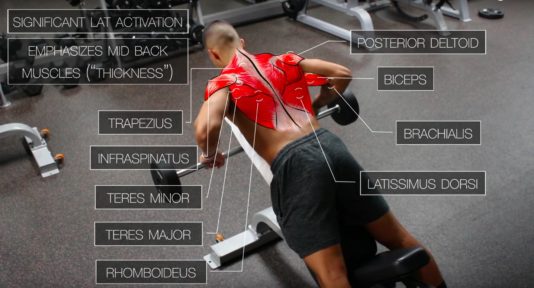
Back Workout Routine For a More Developed Back
If you want to learn what it takes to create the "best back workout", then you need to read this article because it covers the best back exercises.
I used to be like most other gym-goers; focus on training the muscles everyone CAN see and neglect the ones they can’t. We spend all our time focusing on the chest, shoulders, and biceps yet we tend to neglect the back and legs as a result.
And aside from just not taking their back workout seriously, most people end up choosing the wrong combination of exercises.
Want to avoid this deadly training mistake - and build an amazing, well-rounded physique in the shortest time possible? Then you're going to love the science-backed programs I've created. Each of them is designed to be an all-in-one process to help you achieve your fitness goals in the most time-efficient way possible. Discover the right program for you below:
Click the button below to take my analysis quiz to discover the best program for you:
↓
Now, well-developed and proportionate back muscles contribute A LOT to an aesthetic physique. Luckily, I realized this and finally started putting more thought and effort into my back workouts. It was only once I started incorporating the evidence-based exercises you'll see in this article that I started noticing significant improvements.
Don't believe me?
Here's where my back development is at now:
Personal Back Development
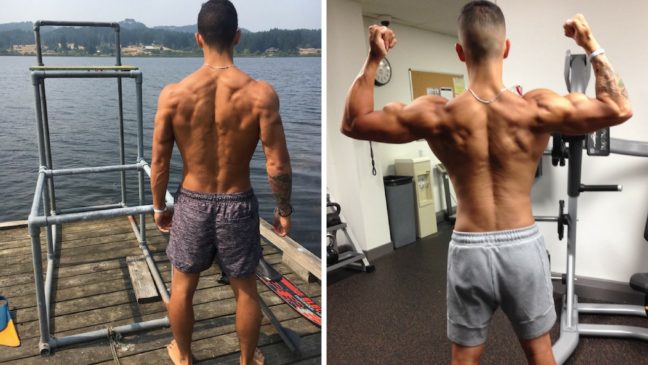
Although I still have a ways to go, I think it's safe to say that I've done a decent job of developing my (once lagging) back musculature.
So what exactly are the best back exercises to include in your routine?
Well, let's first take a look at what exactly we'd want to accomplish with these exercises.
What Creates an "Attractive" Looking Back
One all too common mistake people make with regards to back training is utilizing too many isolation exercises and failing to target all of the back musculature. This includes both superficial AND deep muscles. The four main muscles that make up the bulk of the back and the ones we want to focus on developing are:
- The trapezius (which have an upper and lower portion)
- The rhomboids (which lay under the trapezius muscle)
- The latissimus dorsi (lats)
- The erector spinae (the lower back muscles)
Here's how they look:
Back Muscles
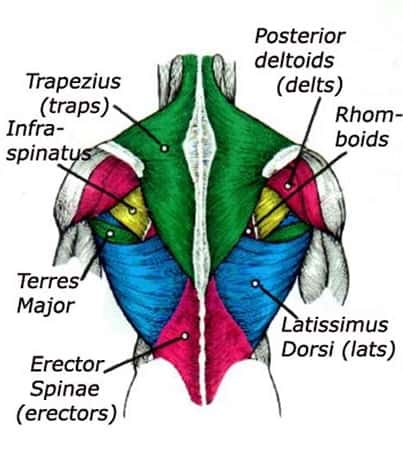
As you can see, there are also a few smaller muscles that serve an important role such as the teres major/minor and the infraspinatus. We want to focus on these muscles as well as they will strengthen our shoulder through stabilization and also help provide an aesthetic appeal.
By focusing on developing the above musculature, we are able to effectively create the following features:
- Large but not overdeveloped upper traps for thickness
- Wide, strong lats that extend down low to create that illusive V-taper
- Strong lower traps and rhomboids for mid-back thickness
- Clear development and separation in the teres major and infraspinatus muscles
- And a well-defined “Christmas tree” structure in the lower back created by the erector spinae and lower lats
You can visually see each of these features in the picture of me below:
Developed Back
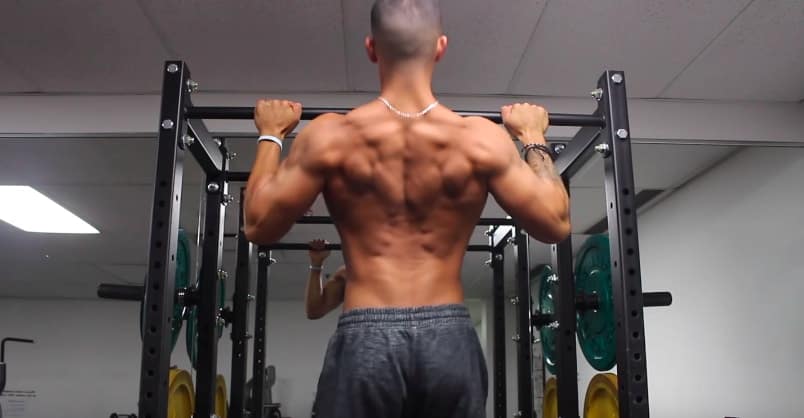
These features are EXACTLY what creates an attractive looking back. It's the "secret formula" that nobody tells you about.
But how exactly do we achieve these features? Well.. This is where we'll need to dig deeper and is where we'll start discussing the best back exercises AND combine it all into the "best back workout" routine.
Muscle Activation Cues (Mind-Muscle Connection)
Before we get started on the exercises I want to briefly talk about muscle activation. We know that establishing a strong mind-muscle connection plays an important role in enhancing muscle activation AND muscle growth. It's something that's been proven time and time again in the literature.
Muscle Activation Studies
For example, one 2009 study by Snyder et al. found that subjects were able to boost activation of the lats by simply incorporating few back-activation cues during the lat pulldown.
And one recent 2018 study by Schoenfeld and colleagues showed that focusing on a strong mind-muscle connection with the biceps during arm curls led to almost double the biceps growth when compared to just trying to "get the weight up".
So long story short - focusing on feeling your back work during these exercises is vital.
But how exactly do we do this? Easy! We use a few activation cues and various tips/tricks I've learned over the years.
Here are a few:
1. Think about "pulling" with your elbows as opposed to thinking about pulling with your hands. This applies for all back exercises.
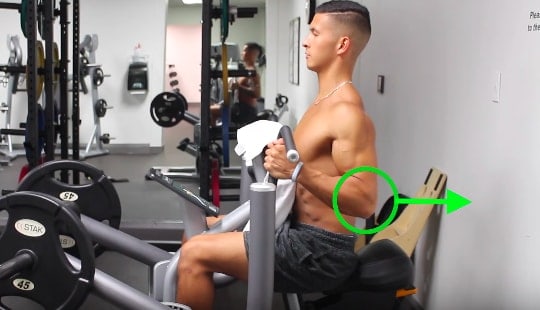
2. Bring your shoulders down and away from your ears to depress/relax your traps before (and during) each exercise.
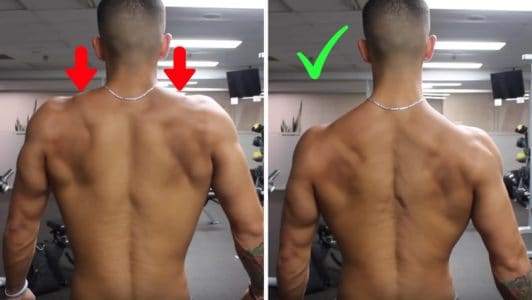
3. Try utilizing a "thumbless grip" by removing your thumb from underneath the bar/dumbbell/grip and put it over the grip with your fingers. This often works wonders in terms of lessening the involvement of the biceps in the movement and making it easier to feel the back actually working.
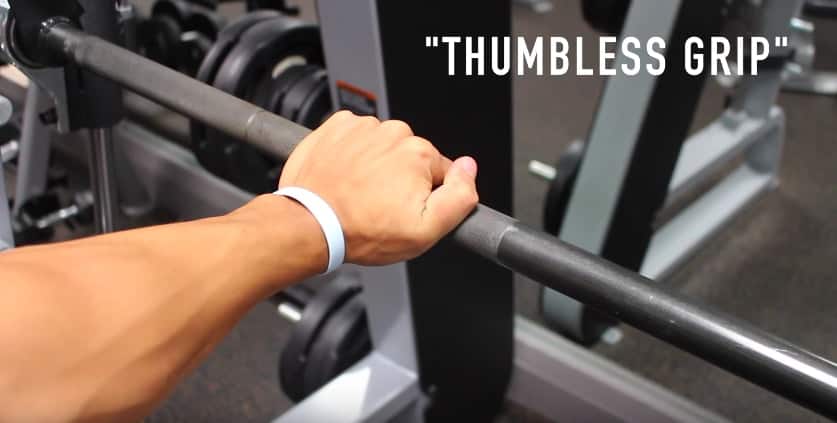
Using these cues will help you maximally activate and grow the muscles that should be working in the following back exercises.
Love exercise cues like these? Then you're going to appreciate our 3-on-1 coaching. Along with my team of experts, the BWS team is going to coach you every step of the way - so you perform your exercises in a way that'll get you the quickest results possible. To find out more:
Click the button below to find out more about the 3-on-1 coaching program:
↓
Top Exercises
Exercise #1: Deadlifts OR Rack Pulls
If deadlifts currently aren’t somewhere in your lifting routine, I highly suggest you start doing them. It’s a great compound movement to target virtually all of your upper and lower back muscles.

They mainly add thickness to the back by heavily stimulating the trapezius muscles, but will also contribute to growth of the lats since they will be assisting throughout each rep. In addition, the ability to easily overload this exercise and work up to heavy weights with it makes it a no-brainer to include for overall back hypertrophy.
And for those wondering, yes they are safe. Numerous studies have shown that not only are deadlifts safe for the back, but they actually seem to prevent back injuries from occurring by strengthening the core musculature.
However, the catch is that you must perform them with proper form and avoid excessive rounding/arching of the lower back. Although this is a topic for another article, I strongly advise you do your research into how to properly perform them beforehand.
Now in the event that you can't do deadlifts or would prefer to do them on your legs day, I would opt for using above-the-knee rack pulls here instead.
Why? Because it's the only other exercise that enables you to handle very heavy loads in order to fully stimulate the traps and overall back musculature. And since the range of motion with this exercise is much less than that of a deadlift, it makes it a convenient option for those who struggle with deadlifts due to past injuries.
As for how to do them, simply set up a power rack to just above the knees and pull the bar up as you would in a traditional deadlift. The only difference now is the greatly reduced range of motion.
Exercise 2: Pull-Ups
This is probably my favourite exercise for several reasons. First of all, not only does it work pretty much all of your back musculature like your lats, lower traps, and rhomboids, but they also greatly increase the role of your all-important shoulder and scapular stabilizers like the teres muscles and the infraspinatus.
Pull-Up Muscles
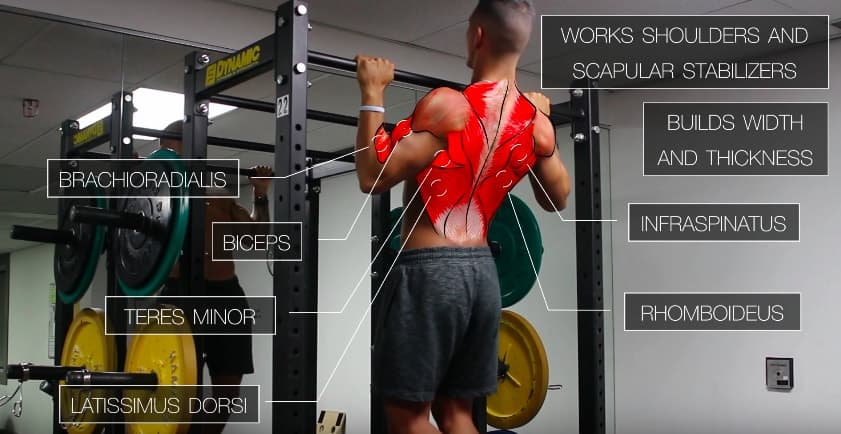
And the fact that it’s a closed chain exercise (meaning that the hands are held at a fixed anchor point) suggests that it may result in greater motor unit recruitment of the back muscles. This has been demonstrated in several studies that compared open-chain exercises like lat pulldowns with closed chain exercises like the pull up.
Pull-Ups vs Chin-Ups?
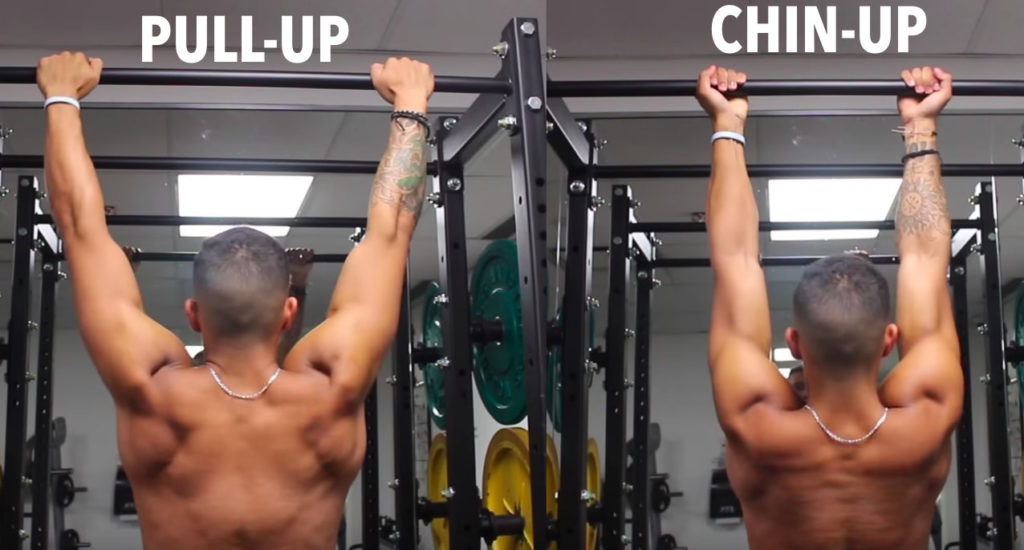
Now as for whether you should do pull-ups or chin-ups, research, tends to show that both pull-ups and chin ups provided equal lat activation.
However, this same study showed:
- Greater lower traps and infraspinatus activation with the pull-up
- Greater pectoralis major and biceps activation with the chin-up
Thus, given that we are focusing on maximizing back growth, pull ups seem like the better option for this reason.
However, some may get better overall back activation with chin ups as opposed to pull ups. EMG studies provide us with good insight but doesn't account for individual variation. So try them both out and see which feels better for you - you can always include both in your workout if you wish.
I personally find that a fairly wide (a little wider than shoulder-width) overhand thumbless grip pull up best activates my back.
Now as for progressive overload, once you can comfortably perform 10-12 clean reps of a bodyweight pull up, I suggest starting to gradually add weight to the movement. This can be done by using a weight belt or holding a dumbbell between your feet in order to continuously progress this exercise.
But if you're currently unable to do a pull-up, I'd suggest utilizing an assisted pull-up machine and incorporating pull-up "negatives" to build the strength to do bodyweight pull-ups.
Exercise #3: Chest-Supported Rows
Next you want to move onto a horizontal rowing movement. One study by Lehman and colleagues actually found that the row provides "similar levels of lat activation as lat pulldowns but more activation in other areas of the back like the traps and rhomboids."
Chest-Supported Row Exercises

So I definitely suggest you include a rowing type movement into your back workouts to hit these other muscles.
I'd personally suggest using a chest-supported horizontal row in this workout since it minimizes the involvement of the lower back in the movement. This is because research shows that back exercises that involve less lower back involvement often provide better upper back activation. And since your erector spinae has already gotten a good workout from the deadlifts performed earlier, let's just say that your lower back will thank you!
Exercise #4: Lat Pulldowns
Although the pull-up can definitely be argued as a superior exercise when compared to lat pulldowns, the lat pulldown is an excellent supplemental exercise to use. It targets similar muscles as the pull-up, just with less involvement of the shoulder stabilizers.
As for the best variations to perform them, in my opinion overhand middle and wide grip front pulldowns with a slight lean back are likely the best options.
Middle Vs. Wide Grip

Why is this? Well, let's take a look at the different variables.
Best Lat Pulldown Variation:
Front pulldowns have been shown in many studies, such as this one by Barros and colleagues, to be superior in terms of lat activation when compared to other variations like behind-the-neck pulldowns and V-bar pulldowns.
Let's not forget that front pulldowns also don't place your glenohumeral joint in a compromised position as behind-the-neck pulldowns do, so stick to front pulldowns!
Slight Lean Back:
I recommend slight lean back during the pulldown based on the conclusions of this study, which demonstrated that "a slight lean back at 135 degrees led to an 11% increase in lat activation as long as no momentum is used." Thus, a slight lean back is optimal but you don’t want to be swinging every rep!
Hand Grip/Placement:
As for hand grip, one study by Lusk and colleagues concluded that a "pronated (overhand) grip had significantly higher lat activation when compared to a supinated (underhand) grip during lat pulldowns". Which is why I recommend using an overhand grip.
Grip Width:
And for grip width, this study by Andersen and colleagues examined the activation of various back muscles using 3 different grip widths: narrow, medium, and wide. The researchers concluded that the 3 different grip widths exhibited very similar lat activation. BUT the biceps were most activated with the middle grip AND subjects were able to lift the most weight with the middle grip.
So it seems that the middle grip is superior to the other grips as it provides equivalent lat activation but more biceps activation and the ability to lift heavier weight. However, the same study also showed that during the eccentric portion of the movement, the infraspinatus (one of our rotator cuffs) was better activated during the wide grip. And given that a wider grip will also involve more of your teres major muscles due to its anatomical position and function, I think we can conclude that using a combination of both the middle and wide grip is best in terms of back development.
Exercise 5: Scapular Pull-Ups
This last exercise is something I highly suggest you add into your back training workouts to finish it off. They’re called scapular pull-ups and mainly strengthen your lower traps. This helps with improving your scapular stability and keeping your shoulders healthy.
Scapular Pull-Up Muscles
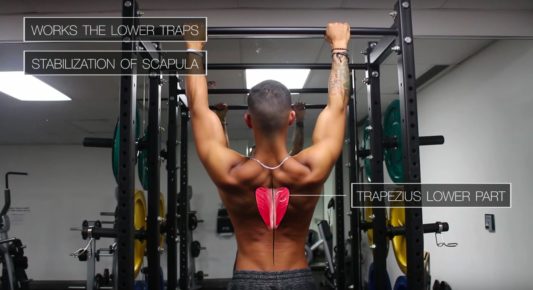
You simply want to hang from a bar, depress your shoulders down and away from your ears and pull your body up without allowing your elbows to bend with a slight pause at the top of the movement.
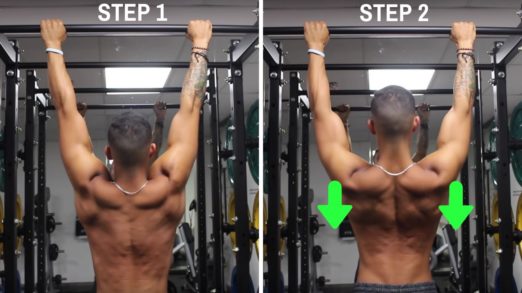
As you get stronger with this exercise you can always progress it by performing more reps, using a slower tempo, or using a weight belt to gradually add weight to the movement.
Sample Back Workout Routine
So to wrap this all up, here’s a sample back workout you can do using the 5 exercises I discussed.
Deadlifts: 3-4 sets of 6-8 reps
Pull-Ups: 3-4 sets of 6-10 reps
Chest-Supported Row: 3-4 sets of 10-12 reps
Lat Pulldowns: 3-4 sets of 10-12 reps
Scapular Pull-ups: 2-3 sets of 8+ reps
You want to stick with this routine for a couple months and focus on progressively overloading these exercises. Then once your strength plateaus you can do different variants of the exercise, switch up the order, and so on to keep progressing.
And for those wondering "is this back workout for men only"? No! If you're a female and looking to development a strong looking back, then all of the above information will apply to you as well.
Incorporating The Back Exercises Into Your Current Routine
A lot of you probably don't run typical "bro-splits" with a full day dedicated to your back workout. Thus, for those running an upper/lower split or a push/pull/legs routine, I'd suggest incorporating 2-3 of the above back exercises into one of your upper or pull days and incorporate the rest on the other day. If you're still confused about this, I show an example of how to do so in my upper body workout article.
And for a complete step-by-step science-based program that shows you exactly how to train, eat, and recover week after week to maximize your results, then:
Click the button below to take my analysis quiz to discover the best program for you:
↓
But that's pretty much it for this article. I hope you all enjoyed it and found it useful. As always, let me know in the comments if you have any questions/concerns I can help you with. And show me your support by giving me a follow on Instagram , Facebook , and Youtube where I’ll be posting informative content on a more regular basis. Cheers!


